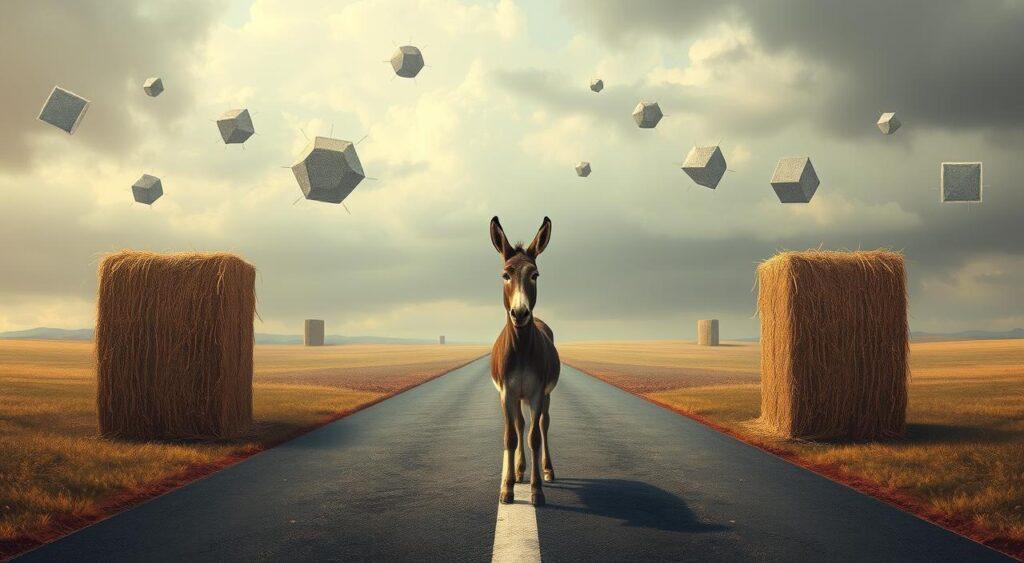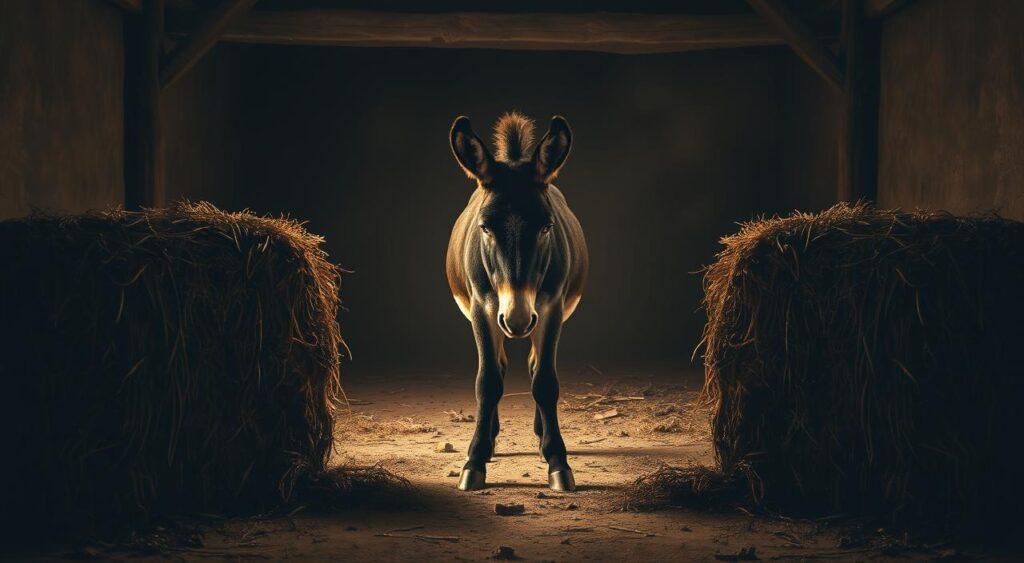Have you ever felt stuck between two equally good choices? Imagine standing in front of identical meals, unable to pick one. This dilemma lies at the heart of the Buridan Ass mental model—a classic paradox about decision paralysis.
The idea traces back to ancient philosophy. Aristotle first explored scenarios where a “man must necessarily” choose between identical options. Centuries later, scholar Jean Buridan revived the concept using a donkey as an example. If placed exactly between two identical hay piles, the animal might starve—unable to decide.
But why does this matter today? Modern life bombards us with endless options. Should you take that job offer or stay put? Buy the blue shirt or the red one?
Like the donkey, we sometimes freeze when choices seem equal. The model highlights how overthinking can trap us in inaction.
Ready to stop spinning in circles?
Key Takeaways
- The Buridan Ass mental model illustrates how indecision arises when options appear identical.
- Rooted in debates about free will, it challenges ideas about rational choice.
- Ancient philosophers like Aristotle laid groundwork for this paradox.
- Real-world examples include career moves, purchases, or daily routines.
- Small biases or external nudges often break decision deadlocks.
- Understanding this model helps recognize and avoid analysis paralysis.
Background and Historical Context

What if choosing felt impossible—not because options were bad, but because they seemed exactly the same? This puzzle captivated thinkers for centuries, starting long before modern psychology existed.
Aristotelian Origins and Early References
Aristotle first explored this dilemma in On the Heavens. He described a man torn between equal urges for food and water. Without a stronger desire, how would anyone act? The philosopher argued that action requires unequal preferences—a spark to tip the scales.
Medieval Perspectives: Jean Buridan and Al-Ghazali
Centuries later, scholars like Jean Buridan expanded the idea. His famous donkey example asked: What happens when an animal, like a hungry thirsty donkey, faces identical hay piles? The creature might starve, frozen by perfect balance.
Meanwhile, Persian thinker Al-Ghazali debated similar scenarios, questioning whether true free will could exist without differences to guide us, as the philosopher considered the implications of choice in the face of hunger and thirst.
These debates weren’t just about hungry animals. They shaped bigger questions: Are choices driven by logic alone? Can tiny differences—like a breeze moving one hay strand—break deadlocks? By medieval times, this paradox became a tool to explore moral determinism and human agency, illustrating the struggle of the man torn between the thirst for knowledge and the hunger for sustenance.
Sound familiar? Today’s “analysis paralysis” echoes these ancient puzzles. Next time you’re stuck between two great options, remember—you’re part of a 2,000-year conversation about how we choose.
Exploring The Buridan Ass Mental Model

Why do we freeze when faced with two great options? The answer lies in a classic puzzle where perfect balance creates chaos. When choices appear identical, our brains struggle to pick—like a computer glitching between two commands.
Key Concepts and the Paradox Explained
Imagine standing between two subway exits. Both lead to your destination equally fast. Minutes pass as you overthink—this is the paradox in action. Equal options create a mental tug-of-war. Unlike physical processes (water flowing downhill), humans weigh invisible factors: fear of regret or hope for perfection.
Digital engineers face similar issues. Circuits sometimes get stuck between states, called metastability. Just like us, they need a “nudge” to resolve uncertainty. Time matters too. Wait too long, and opportunities fade—like a train leaving while you’re still deciding.
Debates in Determinism and Free Will
Philosophers ask: Do tiny differences break deadlocks, or do we create them? A breeze moving one hay pile saves the hungry animal. A coin flip decides your lunch order. These external factors challenge pure “free will” ideas, especially when we consider how thoughts of death can influence our choices.
Modern life mirrors this. Choosing between job offers? One might have better coffee—a small bias breaking the tie. Ever delayed a choice because both options looked perfect? You’re not alone. Recognizing this pattern helps us embrace imperfections and make decisions more confidently.
Practical Applications and Overcoming Decision Paralysis
![]()
Ever watch a spinning loading icon, waiting for a webpage to resolve? That’s what happens when systems—or people—get stuck between choices. Modern tech faces similar dilemmas to our ancient paradox, but engineers have clever fixes we can borrow.
Digital Logic and Metastability in Modern Systems
Computers use circuits to make split-second choices. But when signals arrive simultaneously, components freeze—a glitch called metastability. Engineers solve this by adding “arbiters” that force a decision after nanoseconds. Like flipping a coin when two paths look identical.
| Problem | Tech Solution | Life Hack |
|---|---|---|
| Conflicting inputs | Priority-based arbitration | Set personal rules (e.g., “Pick the left option”) |
| Endless loops | Time-out mechanisms | Use deadlines (“Decide by noon”) |
| Data corruption | Error-checking protocols | Review past choices monthly |
Buridan Ass Mental Model and Decision Strategies
Stuck between two job offers? Try the “coin test.” Flip a coin—your gut reaction to the result reveals what you truly want. Studies show overthinking wastes 17 minutes daily for the average person.
Set micro-deadlines. Give yourself 90 seconds to choose lunch spots. If stuck, default to yesterday’s pick. Tiny biases—like preferring salads on Mondays—act as tiebreakers. Remember: A thirsty traveler doesn’t debate water sources—they drink.
Conclusion
What happens when two perfect paths appear before you? The ancient dilemma of equal choices- the buridan ass mental modelstill shapes our lives.
From Aristotle’s hungry-and-thirsty man to modern tech’s decision circuits, history shows one truth: action beats endless thinking. In the context of the Buridan ass thought experiment, the challenge of making a decision can lead to a paralysis that feels akin to death.
Set simple rules to break deadlocks. Choose the left sandwich if lunch spots look identical. Flip a coin and notice if relief or disappointment follows. Like engineers adding time-outs to glitching systems, give yourself deadlines. As explored in this philosophical puzzle, tiny nudges—a breeze, a sip of water—often decide outcomes.
Next time you’re torn between coffee or tea, remember: movement creates clarity. Will you wait until the train leaves, or step aboard? Understanding these patterns helps every person avoid spinning in circles. For more tools to cut through indecision, explore practical strategies used by decisive thinkers.
Trust your ability to choose. While the best course isn’t always perfect—it’s the one that gets you moving.


